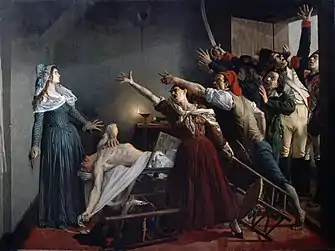Jean-Joseph Weerts
Jean-Joseph Weerts (1 May 1846, Roubaix - 28 September 1927, Paris) was a French painter of Belgian origin who worked in the Academic style.
.jpg.webp)

Biography
His father was a mechanical engineer who gave him his first introduction to drawing. Later, in 1858, he attended the Académie des Beaux-arts de Roubaix. With a pension (stipend) from Roubaix, he enrolled at the École des Beaux-arts in 1867, working in the studios of Alexandre Cabanel.
He produced nearly 700 works, including portraits and paintings on historical and religious themes. The Death of Bara earned him the Légion d'honneur in 1884.[1] He also decorated a number of public buildings throughout France and participated in several official projects for the Third Republic, including the Hôtel de Ville, the Sorbonne and the Hôtel des Monnaies. He also worked at the Limoges City Hall and the College of Medicine in Lyon.
He was buried at Père-Lachaise,[2] and a street in Roubaix was named after him. A monument in his honor was created by the sculptor Alexandre Descatoire and may be seen in Roubaix's Parc Barbieux.[3]
See also
References
- Dossier @ the Base Léonore
- Paul Bauer, Deux siècles d'histoire au Père Lachaise, Mémoire et Documents 2006 ISBN 978-2-914611-48-0, pg.782
- "L'hommage de Roubaix au peintre J.-J. Weerts", Le Petit Parisien, 30 November 1931
Further reading
External links
- ArtNet: More works by Weerts
- "La Piscine exhibits its Weerts" by Didier Rykner from the Art Tribune
- Fresco in the Grand Amphitheater at the University of Lyon 2, 15 meters long, 7 meters high. Archived 2016-09-08 at the Wayback Machine
- France! or the Despair of Alsace and Lorraine, Musée Lorrain in Nancy